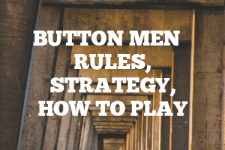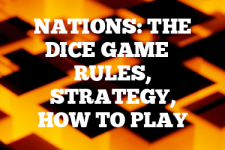Boggle: Strategies, Rules, and Tips Guide
Introduction
Boggle is a word game that’s been around for a while. It’s a game where you shake up a bunch of dice with letters on them, then try to find as many words as you can before time runs out. It’s a simple idea, but I find there’s a lot to it once you start playing and it really stretches your word talents. The game was first created by Allan Turoff and has been a hit since the 1970s. It’s a mix of luck and skill, and it’s a great way to test your vocabulary and your ability to spot words quickly.

The game is made up of 16 cubic dice, each with a different letter on each side. These dice are placed in a special tray with a cover. You shake the tray, and when you lift the cover, the dice settle into a 4×4 grid. The goal is to look at the letters and find words by connecting letters that are next to each other. You can go up, down, left, right, or diagonal on connecting dice, but you can’t use the same letter cube more than once for the same word.
When the timer starts, you start writing down all the words you see. When the timer stops, everyone shows their list, and you score points based on the words you found. The longer the word, the more points you get.
Quick Tip for Boggle
Always look for suffixes like -ING, -ED, or -ER to extend simple words into longer ones for more points. Also, don’t forget plurals (adding an S)!
Rules for playing Boggle
Playing Boggle is pretty straightforward, but there are some rules you need to know. First, you’ve got to be playing with at least one other person. You can play with a big group too, which can be a lot of fun. Here’s how the rules break down:
- Shake the Boggle tray with the cover on so the dice fall randomly into the grid.
- Start the timer (usually three minutes) once everyone is ready.
- Find and write down words by connecting adjacent letters. Remember, you can’t skip over letters, and you can’t use the same letter cube more than once per word.
- When the timer runs out, everyone stops writing.
- Compare your list of words with the other players. Any words that appear on multiple lists get crossed out and don’t count.
- Score points for the words that are left. The scoring system is usually like this: 3 and 4-letter words are worth 1 point, 5-letter words are worth 2 points, 6-letter words are worth 3 points, 7-letter words are worth 5 points, and any word longer than that is worth 11 points.
- The player with the highest score at the end of the round wins that round.
- You can play as many rounds as you like, and the person with the highest total score at the end wins the game.
There are a few more details, like what counts as a word. It’s got to be a real word that you could find in a standard dictionary. No proper nouns, abbreviations, or foreign words that aren’t in the dictionary.
Equipment and Setup for Boggle
To play Boggle, you need a Boggle set. This includes the tray with a cover, 16 letter dice, and a timer. Some versions of the game might come with a sand timer, but you can also use a stopwatch or a phone timer.
Setting up the game is easy:
- Place all 16 dice into the tray.
- Secure the cover on top.
- Shake the tray so the dice settle into the grid slots.
- Remove the cover and place it to the side.
- Set the timer within easy view of all players.
Once the setup is done, you’re ready to play.
How to Play Boggle
Playing Boggle involves a few key steps. Here’s what you need to know:
- Key Game Mechanics: You’re looking for words in a grid of letters. Words can be formed from letters that are adjacent to each other in any direction.
- Setup: After shaking the dice in the tray, you reveal the grid and start the timer.
- Gameplay: Write down all the words you see before the timer runs out. Words must be at least three letters long.
- End of the Game: When the timer stops, compare words with other players, cross out duplicates, and score the remaining words.
Here’s a breakdown of the gameplay phases:
- Word Searching: Look for words in the grid by connecting adjacent letters.
- Writing Down Words: Write down the words you find on a piece of paper.
- Scoring: After time is up, score points based on the unique words you found.
How to Win at Boggle
Winning at Boggle isn’t just about having a big vocabulary. It’s also about strategy. Here are some tips:
- Start by looking for longer words. They’re worth more points, and you might see smaller words along the way.
- Look for common word endings like -ING, -ED, or -S to extend words.
- Keep an eye out for prefixes like RE-, UN-, or PRE-.
- Practice makes perfect. The more you play, the better you’ll get at spotting words quickly.
- Stay focused during the game. If you get stuck on one part of the grid, move to another section.
Remember, it’s not just about finding words; it’s about finding words that other players don’t see. So, think outside the box and go for the less obvious choices.
Best Strategies for playing Boggle game
When it comes to Boggle strategy, there are a few things to keep in mind:
- Look at the whole grid and try to see all the possibilities. Don’t get tunnel vision on one part of the grid.
- Use all your senses. Sometimes, saying the letters out loud can help you see words that you might miss if you’re just looking.
- Keep track of time. Don’t spend too long on one word. If you can’t find it quickly, move on and come back to it later if there’s time.
- Learn from your mistakes. After each round, look at the words you missed and try to remember them for next time.
- Play with friends who challenge you. Playing against people who are really good at the game can help you improve.
Some sneaky tactics might include writing down plurals of words you find or using different tenses of verbs. Just remember, if someone else spots the same trick, those words won’t count for either of you.
Variations
There are a few different ways to play Boggle that can mix things up:
- Play without crossing out duplicate words. This can lead to higher scores and a different kind of challenge.
- Set different time limits. Try playing with a longer or shorter timer to see how it changes the game.
- Use a theme. For example, you could say that all words have to be related to food or animals.
These variations can make the game feel new and interesting, even if you’ve played it a lot.
Scenarios
Sometimes you’ll find yourself in tough spots during a game of Boggle. Here’s how to handle them:
- If you’re stuck and can’t find any words, shake up your perspective. Look at the grid from a different angle or start with a different letter.
- If you keep finding the same words as someone else, try to focus on less common letters or combinations that might lead to unique words.
- If you’re way behind in points, go for broke. Try to find the longest, most complicated words you can, even if it’s a bit of a risk.
Turning these scenarios to your advantage is all about staying calm and thinking creatively.
Frequently Asked Questions about playing Boggle game
Here are some common questions people have when playing Boggle:
- Q: Can I use a word more than once?
A: No, each word can only be used once per round. - Q: Do names of places or people count?
A: No, proper nouns are not allowed. - Q: What if two players write down different forms of the same word?
A: Both words count as long as they’re not exactly the same. - Q: Can I use a dictionary while playing?
A: Usually, dictionaries are only used to settle disputes about whether a word is valid. - Q: How do we decide who wins if there’s a tie?
A: You can play a tiebreaker round, or share the victory!
Related Subtopics
There are a few other things worth knowing about Boggle:
- Boggle apps and online versions can be a great way to practice.
- There are Boggle tournaments for serious players.
- Some people like to customize their Boggle set with different dice for a new challenge.
Exploring these subtopics can help you get even more out of the game.
External Links
For more information on Boggle, check out these links:

A digital native around since the early days of online gaming communities around 2001. An early contributor to the cult gaming site ClanTemplates, Adam has spent years giving free gaming resources to the community. With BoardCards, Adam is most experienced and commonly writing the articles on Strategy multi-player games like Settlers of Catan and Avalon. His first introduction to board games was via Mancala, an Egyptian-origin stone game and one of the oldest known games still played worldwide. Contact me via email



